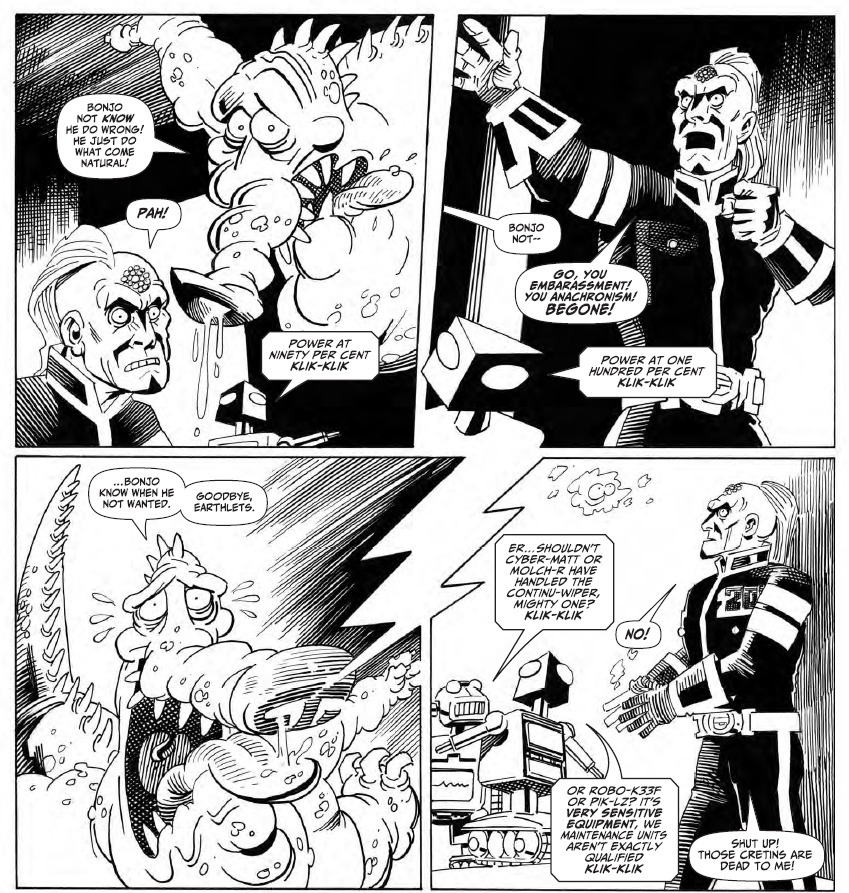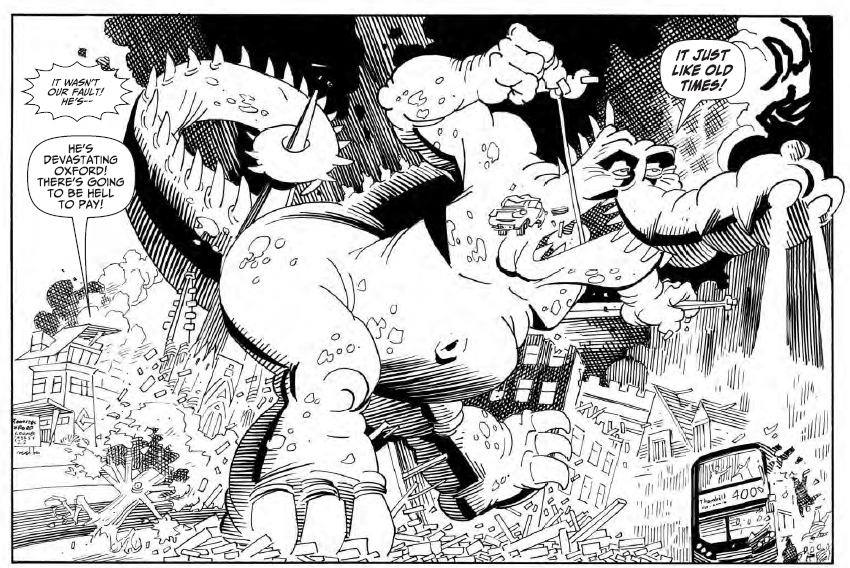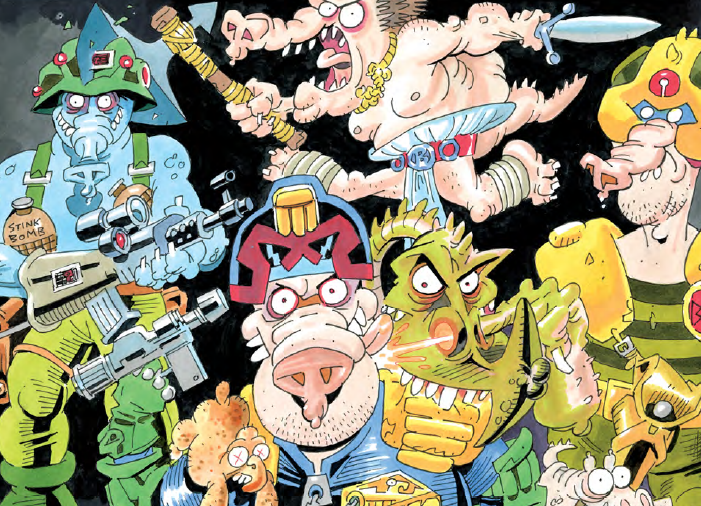Trailed like an earth-shattering event, complete with knowingly oblique text and zoomed-in image teases on social media—which had salivating fans offering up everything from another Judge Dredd Vs. Aliens crossover to a revival of John Wagner’s and Ian Gibson’s long-inactive Robo-Hunter as two of the most repeated (and consciously undersold) guesses—Garth Ennis’s and the late Kevin O’Neill’s "Bonjo from Beyond the Stars in: Solids in the Bile Tube" is the unexpected centerpiece of this year’s Christmas issue of 2000 AD, #2312. The duo are quickly reconvened following their excellent “Kids Rule O.K.” collaboration for Rebellion’s recent Battle Action special, in which Ennis and O’Neill delivered a two-tiered deconstruction of the bobby-lashing Carlos Ezquerra cover that got the Action portion of the crossover comic in trouble with Britain’s red top newspapers.
Created solely by O’Neill way back in 1977, Bonjo from Beyond the Stars was a comedic take on the giant monsters of the silver screen, with a greater emphasis on weeping, spotted snouts, and choking clouds of eggy flatulence. The character originally intruded upon the Galaxy’s Greatest Comic in a series of short scatalogical strips, these digressions running from issues #41-50 before being collected—and completed, with a suitably grotesque pin-up of a triumphantly swollen Bonjo—in the 1984 2000 AD Annual. Barely padding out three pages in that hardback stocking filler, these vintage tales revolved around the oafish creature accidentally foiling a superpowered aardvark inspired by early 2000 AD stablemate (and acknowledged The Six Million Dollar Man rip-off) M.A.C.H.1 as well as a caricatured Chinese supervillain very much riffing on Sax Rohmer’s Fu Manchu - apparently a recurring fascination for the artist, as an anonymized version of the Devil Doctor was later seen sneering his way through the concluding issues of the first volume of O’Neill’s and Alan Moore’s The League of Extraordinary Gentlemen. The linework that O’Neill conjured up for these early pieces was atypical, even when compared to the longer strips the artist was delivering during the same period. Bonjo was much more bubbly and deliberately cartoonish than O’Neill’s other pre-Nemesis the Warlock work.

Most obviously, Bonjo’s adventures lacked the sweeping dimension of Credo’s war on Terra. The pages read as if drawn physically smaller, a series of cigarette packet sketches with an even-looser connective plot. Backgrounds and other scene-setting imagery (elements key in O’Neill’s later works) were largely absent. The most striking images of the eponymous monster saw O’Neill paying tribute to the bulging eyes and pinhole pupils whizzed out by Ken Reid, the cartoonist who devised Roger the Dodger for DC Thomson’s bulletproof children’s comic The Beano and, later, serialized grotesqueries like Faceache for IPC’s Jet and Buster. Reid, an acknowledged and apparent influence on O’Neill’s style, was a master of caricature and anthropomorphization, rendering the usually drab or starkly inanimate with the kind of winking malevolence that O’Neill would later weave into his own charnel house spreads.
Among O’Neill’s first published pages for 2000 AD were “Tharg and the Intruder!” in issue #24, a three-page framing device for the then-forthcoming Tharg’s Future Shocks feature that saw the alien editor torturing a young boy who prefers reading transatlantic reprints from Wonder (i.e. Marvel) Comics. A few weeks later, in issue #28, O'Neill drew an episode of the newly-launched Future Shocks entitled “Wings”. O’Neill also wrote these stories. “Wings” is closer in execution to his later work with Pat Mills on Ro-Busters; it’s a brief, action-packed sequence of shattering glass, machinery peppered with flowering, spiked squibs, and a cast who willingly seal themselves in chromed battle suits. “Tharg and the Intruder!”, in contrast, functions as a predecessor to the new “Solids in the Bile Tube” - a nascent example of a strip premised on an alien indifference to the clammy frights pumped into the brains of the 2000 AD readership.

Existing, as it does, at the beginning of 2000 AD’s four and a half decade run, “Tharg and the Intruder!” is built around teasing barely established and still-to-come horrors. It’s an in-house advert, in that sense; O’Neill given license to illustrate a page-hogging museum that hosts, amongst others, Dan Dare’s the Mekon, a mannequin sporting a Harlem Heroes uniform and Judge Dredd’s Lawmaster motorbike. The brief yarn concludes by launching head-first into squirming body horror, as O’Neill shows off the kind of inverted viscera that would later give the Comics Code Authority pause when considering his work. Despite a commonality of cast and setting, this new Bonjo episode exists in a completely different time and space, one in which the forthcoming thrills of 1977 have been consigned to the overstuffed oblivion of a filing cabinet’s defunct drawer. Ennis’s and O’Neill’s Bonjo revamp therefore not only revisits a character that ran out of steam almost immediately, it reexamines the fictional hierarchy of a comic that has its editors communicate in a litany of alien lingo while re-casting its human creators as a bevy of overworked, oil-leaking robots.
How should the overlord of 2000 AD, Tharg the Mighty, be drawn? Early glimpses of the Quaxxan overseer—essentially real-life editor Pat Mills’ take on the desiccated EC comic hosts who took great delight in spinning their publication’s horrifying yarns—attempted to maintain the illusion that this creature was a flesh and blood visitor from a distant star. During the foundational years of the late 1970s and early 1980s, black and white photographic images of a suit actor were crammed into stray corners of 2000 AD, heralding the anthology’s forthcoming thrills. These images, often reading as inky smudges on the comic’s bog roll paper stock, are, thanks to Tharg's solid rubber mask, serene and simian; neither as grand as the scowling alien costume IPC would later use in their relaunched Eagle for the magazine's Doomlord photo strip, nor as reptilian as the editor’s Betelguesian origin story would suggest. O’Neill’s draft in "Intruder" follows this preliminary house style: a sneering and immovable face buttoned up into a stiff boiler suit.
Later appearances of Tharg would drop this snapped-at-work quality, employing the 2000 AD Murderers' Row of artistic talent to physically evolve the egotistical extraterrestrial. Carlos Ezquerra’s take was often stern and imperious, staring at the reader down the length of his nose. Brett Ewins gave us a strapping vision of the green-skinned alien in the 1990s; a study not completely dissimilar to that of that other mononymous stud, Fabio, complete with a muscular body and a flowing mane of curled-and-blown hair. These visual discrepancies even had an accompanying fiction: Tharg would periodically shed his outer skin like a lizard, leaving hollow ecdysis all over the Fleetway offices.

For this 2022 follow-up to Bonjo from Beyond the Stars, O’Neill leans into the human-level absurdity of an alien editor who mistreats his staff/subjects (E. George Cowan’s and Ted Kearon’s antiquated Robot Archie catches a stray boot up his malfunctioning arse) and generally behaves like a used car salesman hawking lemons. At rest, O’Neill’s and Ennis’ Tharg is imbued with the smug satisfaction of a Leonard Rossiter sitcom character: a preoccupation with impressing or hoodwinking his social betters, represented here by thinly-veiled allusions to the American comics publishers who each have deeper pockets and a wider readership than the scheming Tharg. When alarmed though, O’Neill’s Tharg transforms into pure elastic - his face contorted with the same explosive expression as a Tex Avery cartoon character.
Bonjo is even more entertaining. Seemingly conscious of being watched, Bonjo locks eyes with the reader when imperiled, cramming its enormous physique into panel corners to offer up a series of pleading grimaces. This is not a heroic monster assured of its inherent invincibility; this is a creature intimately acquainted with complete oblivion. The level of panic O’Neill charts on this snouted fizog is truly tremendous: sharp, icicle teeth gnashing around a tongue spotted with weeping fungiform, eyes inflated to the point of near detonation. When off the leash, Bonjo is ecstatic, a pirouetting titan wreathed in rubble. Its preoccupation with scooping up buildings and scoffing them down is more Chewie the Chewitsaurus than Godzilla, but O’Neill doesn’t spare readers the inherent horror of a creature the size of skyscraper moving through a populated area.
Where a comic like Chris Donald’s Viz bends the chummy iconography of DC Thomson children’s anthologies towards the scatalogical end of the spectrum, O’Neill has consistently been able to contort this visual language towards the nightmarish or surreal. The Leo Baxendale influence is vividly realized; every cannon-fodder extra is portrayed with a prickly (and plucky) individualism as they navigate sulfurous scenarios. Page 6 of “Solids in the Bile Tube” has half of its space dedicated to an image of Bonjo in full swing, tearing down a church steeple with its spiked tail while spitting a half-chewed car out of the corner of its mouth. To the left of its elephantine feet a tree has come to startled life and is in the process of exiting the panel as quickly as its roots will carry it. On the right hand side, a bus cooks beneath Bonjo’s death ray snorts, its passengers pressed up against the plexiglass in tormented throes. A (conveniently) neat summation of O’Neill’s enduring and indelible appeal as a comics artist: all human experience is smashed together in one seething, beautifully-inked tableau.
By the story’s conclusion, Bonjo has, naturally, left the 2000 AD nerve centre in complete disarray. The beast's capture and subsequent execution inadvertently wipes out the comic’s entire cultural history. The affectionate finality of the piece—not just O’Neill’s last work for this comic, but a strip that might well have been designed, specifically, to operate as such—recalls the various shelved contributions to “Tharg’s Head Revisited”, a series of one-shot pages originally commissioned to celebrate issue #500 of 2000 AD back in 1986 that inadvertently revealed genuinely hard feelings amongst the comic’s artists and writers. O’Neill’s own contribution (which, until “Bile Tube”, marked the final appearance of Bonjo) revolved around his trademark hideous imagery and violent page details being deliberately whited-out for censorious purposes.

A common thread elsewhere among the “Tharg’s Head Revisited” submissions was a lack of financial compensation (during the IPC/Fleetway years) for reprinted work. Brian Bolland’s rejected page, written with Pat Mills, followed a creeping attempt by Tharg to flatter the artist into delivering one last iconic pin-up of Dredd. The pen and ink Bolland complains directly to his intruding editor that, although his striking take on the 22nd century lawman is used ubiquitously on tie-in merchandise, he isn’t seeing any residual payments to that effect. The page concludes with a drawing of Dredd on a hobby horse, bouncing on the spot, intoning ‘I am the £aw!’ with ‘TRY REPRINTING THIS!’ pasted across the image. This submission was eventually published in the Judge Dredd Annual 1988, minus the overt preoccupation with remuneration and a panel of a dead Tharg cooking on an inflamed trident. This nonetheless fared better than Mike McMahon’s initial submission, which, as far as I am aware, was only ever reproduced in 1995’s Judge Dredd: The Mega-History, a retrospective book released as a tie-in with the Sylvester Stallone big screen adaptation.
O’Neill’s 2022 farewell is much less stinging but similarly satirical, cross-pollinating all of the classic 2000 AD cast with his own slobbering creation, gifting us the likes of Strontium Bonj and Bonjo Trooper. O’Neill’s discarded, digressive dragon is elevated in this closing gesture—on a gorgeous, fully colored mock cover—from a thrillsucking afterthought into an Alfred E. Neuman-style mascot that can be endlessly dressed-up and reinterpreted.
Singular, both in terms of his inspiration and execution, Kevin O'Neill spent decades dazzling his fans with a comics language so steeped in a feverish individuality that he was able to take any character or creation, whatever their origin, and make them a landmark in his own pyrexial terrain. Equally at home describing how a robot's fingers might peel sighting glass off an opponent's face or lampooning the pop culture icons that had found themselves shivering in the public domain, O'Neill persisted in giving readers the impression that he was capable of absolutely anything. He will be missed terribly.
The post Disgusting Pong: Kevin O’Neill Takes One Final Trip Down the Bile Tubes appeared first on The Comics Journal.



No comments:
Post a Comment